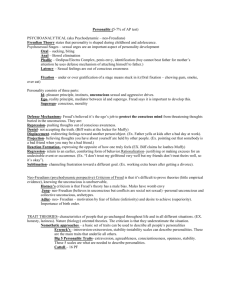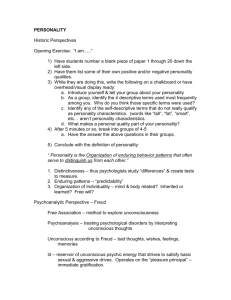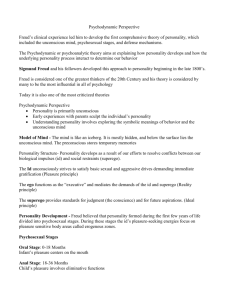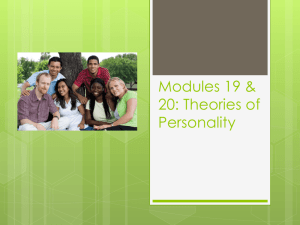Psychoanalytic and Trait Perspective
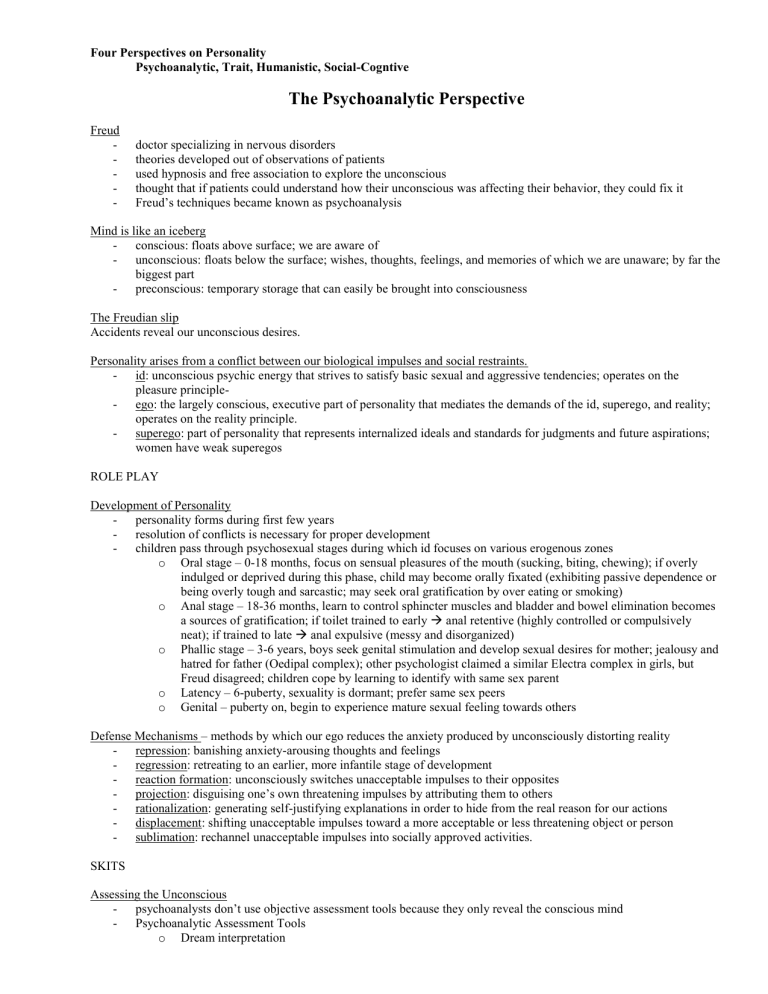
Four Perspectives on Personality
Psychoanalytic, Trait, Humanistic, Social-Cogntive
The Psychoanalytic Perspective
Freud
doctor specializing in nervous disorders
theories developed out of observations of patients
used hypnosis and free association to explore the unconscious
thought that if patients could understand how their unconscious was affecting their behavior, they could fix it
Freud’s techniques became known as psychoanalysis
Mind is like an iceberg
conscious: floats above surface; we are aware of
unconscious: floats below the surface; wishes, thoughts, feelings, and memories of which we are unaware; by far the biggest part
preconscious: temporary storage that can easily be brought into consciousness
The Freudian slip
Accidents reveal our unconscious desires.
Personality arises from a conflict between our biological impulses and social restraints.
id: unconscious psychic energy that strives to satisfy basic sexual and aggressive tendencies; operates on the pleasure principle-
ego: the largely conscious, executive part of personality that mediates the demands of the id, superego, and reality; operates on the reality principle.
superego: part of personality that represents internalized ideals and standards for judgments and future aspirations; women have weak superegos
ROLE PLAY
Development of Personality
personality forms during first few years
resolution of conflicts is necessary for proper development
children pass through psychosexual stages during which id focuses on various erogenous zones o Oral stage – 0-18 months, focus on sensual pleasures of the mouth (sucking, biting, chewing); if overly indulged or deprived during this phase, child may become orally fixated (exhibiting passive dependence or being overly tough and sarcastic; may seek oral gratification by over eating or smoking) o Anal stage – 18-36 months, learn to control sphincter muscles and bladder and bowel elimination becomes a sources of gratification; if toilet trained to early
anal retentive (highly controlled or compulsively neat); if trained to late
anal expulsive (messy and disorganized) o Phallic stage – 3-6 years, boys seek genital stimulation and develop sexual desires for mother; jealousy and hatred for father (Oedipal complex); other psychologist claimed a similar Electra complex in girls, but
Freud disagreed; children cope by learning to identify with same sex parent o Latency – 6-puberty, sexuality is dormant; prefer same sex peers o Genital – puberty on, begin to experience mature sexual feeling towards others
Defense Mechanisms – methods by which our ego reduces the anxiety produced by unconsciously distorting reality
repression: banishing anxiety-arousing thoughts and feelings
regression: retreating to an earlier, more infantile stage of development
reaction formation: unconsciously switches unacceptable impulses to their opposites
projection: disguising one’s own threatening impulses by attributing them to others
rationalization: generating self-justifying explanations in order to hide from the real reason for our actions
displacement: shifting unacceptable impulses toward a more acceptable or less threatening object or person
sublimation: rechannel unacceptable impulses into socially approved activities.
SKITS
Assessing the Unconscious
psychoanalysts don’t use objective assessment tools because they only reveal the conscious mind
Psychoanalytic Assessment Tools o
Dream interpretation
o Projective tests
Provide subject with ambiguous stimulus, then ask them to describe or tell story
Because stimulus is ambiguous, meaning must be read into it based on one’s own interests or conflicts
Thematic Apperception Test (TAT) – show picture, ask subject to make up story
Rorschach inkblot – what do you see in an inkblot; used a lot but no criteria for evaluating; lacks reliability
Others – draw a person, complete sentences, first word that comes to mind
Freud’s followers
neo-Freudians o similarities: id, ego, and superego; importance of unconscious; shaping of personality in childhood; dynamics of anxiety and defense mechanisms o differences: more emphasis on role of conscious mind in interpreting and coping with experiences; doubt that sex and aggression played so large a role in personality
Alfred Adler and Karen Horney – social tensions (not sexual) crucial to personality formation; proposed “inferiority complex”, rejected Freud’s belief that women have penis envy
Carl Jung – Believed in a collective unconscious, a common reservoir of images derived from our species’ universal experiences; he thought this is why different cultures shared common myths and symbols
Contemporary Psychodynamic theory – rejection of psychosexual stages and id, ego, and superego; believe in importance of unconscious and the role that inner conflicts play on our personality formation
Criticism’s of Freud’s theories
little scientific evidence to support his theories
Only offers after-the-fact explanations and is not predictive. This makes it impossible to test.
repression may not exist; while there is anecdotal evidence, studies find that it is either very rare or non-existent
Defense mechanisms that defend self-esteem (reaction formation, projection, rationalization) are well-supported by the evidence
Little evidence to support displacement and sublimation.
The Trait Perspective
Allport
was inspired by an interview of Freud to develop trait perspective; thought Freud was trying to understand the unconscious without first looking to understand the conscious mind
Since then other scientists have tried to identify key traits o Eysenck – 2 traits (extroversion/introversion and emotional stability/instability o
The Big Five – psychologists have used factor analysis to come up with five major traits (emotional stability, extroversion, openness, agreeableness, conscientiousness)
The Big Five are quite stable into adulthood, although some consistently increase with age and others consistently decrease
Heritability – about 50%
Describe personalities in various cultures pretty well
Somewhat predictive of other traits
Biology of traits
Extraverts seek stimulation because normal levels of brain arousal are low; also, PET scans show less activity in areas of frontal lobe that inhibits behavior in extraverts
Emotionally stable people have less active autonomic nervous systems
Preliminary research in molecular genetics indicates that other traits may have biological component
Assessing Traits
personality inventories – questionnaires with items covering a wide range of feelings and behaviors o
Minnesota Multiphasic Personality Inventory (MMPI) is most researched and used.
Empirically derived (originally used lots of items and kept those that were discriminating)
Includes validity scales (assessing extent to which person is faking to look good)
Objectively scored, but easily faked
Criticisms
Personality trait test scores seem to stay fairly stable over time (more stable as we get older), but behaviors are less consistent; behaviors tend to very depending on the situation





